Change Management and Resistance: Lakeland Wonders Report
VerifiedAdded on 2023/04/26
|5
|1649
|321
Report
AI Summary
This report addresses change management within the context of Lakeland Wonders, focusing on the ethical principles and practical strategies needed to navigate organizational change. It examines a scenario where the CEO proposes offshore manufacturing to increase profits, facing resistance from the Senior VP of Operations due to concerns about infrastructure, workforce, and union contracts. The report highlights the importance of effective communication, particularly in addressing employee concerns about job security and outsourcing. Recommendations include establishing clear communication channels, identifying suppliers for outsourced infrastructure, and creating a sense of urgency to facilitate the change process. The report emphasizes the need for ethical change management to ensure a smooth transition and achieve desired organizational growth. The report also references key literature in the field of change management, including works on organizational culture, employee adaptability, and the integration of project and change management.
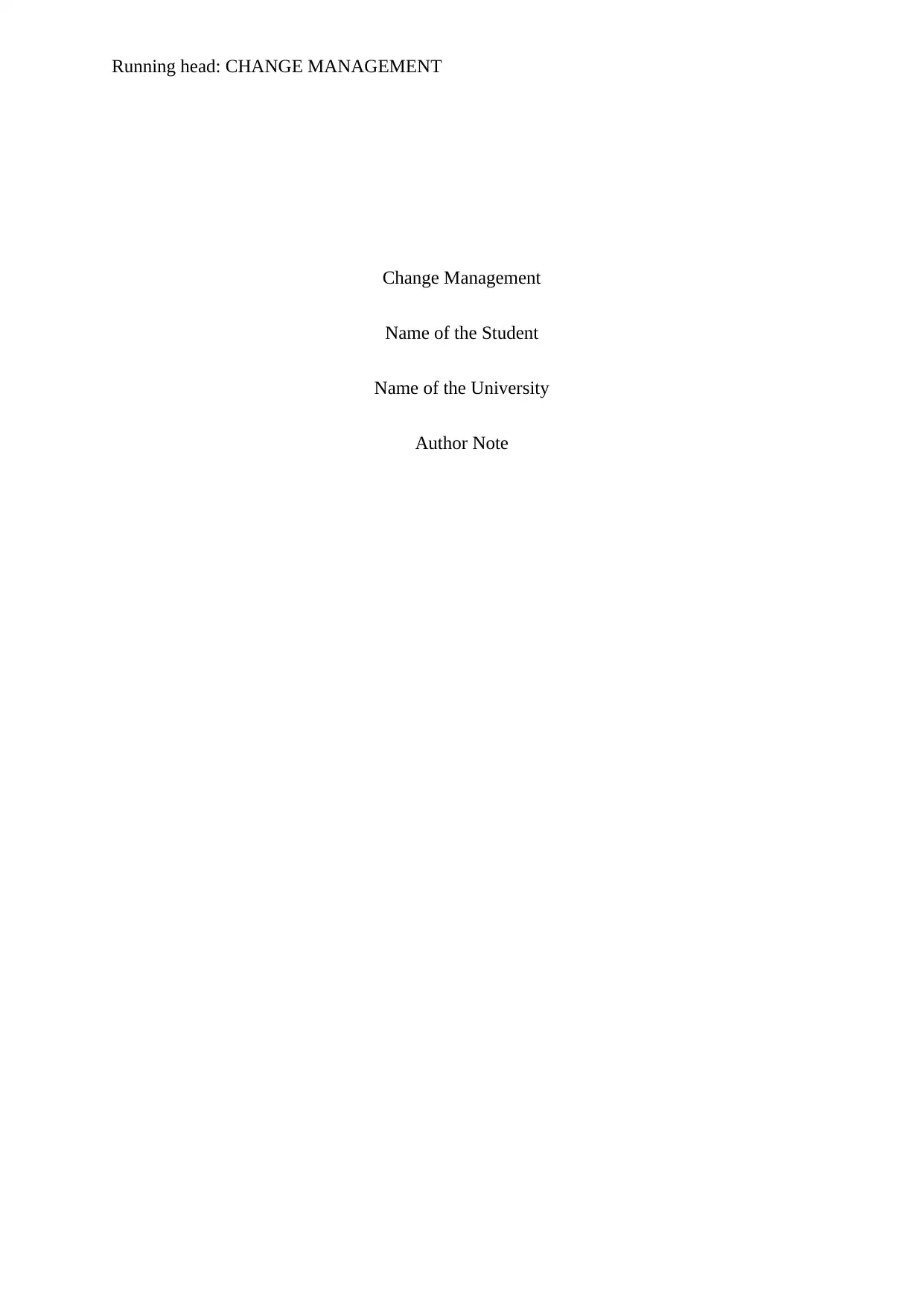
Running head: CHANGE MANAGEMENT
Change Management
Name of the Student
Name of the University
Author Note
Change Management
Name of the Student
Name of the University
Author Note
Paraphrase This Document
Need a fresh take? Get an instant paraphrase of this document with our AI Paraphraser
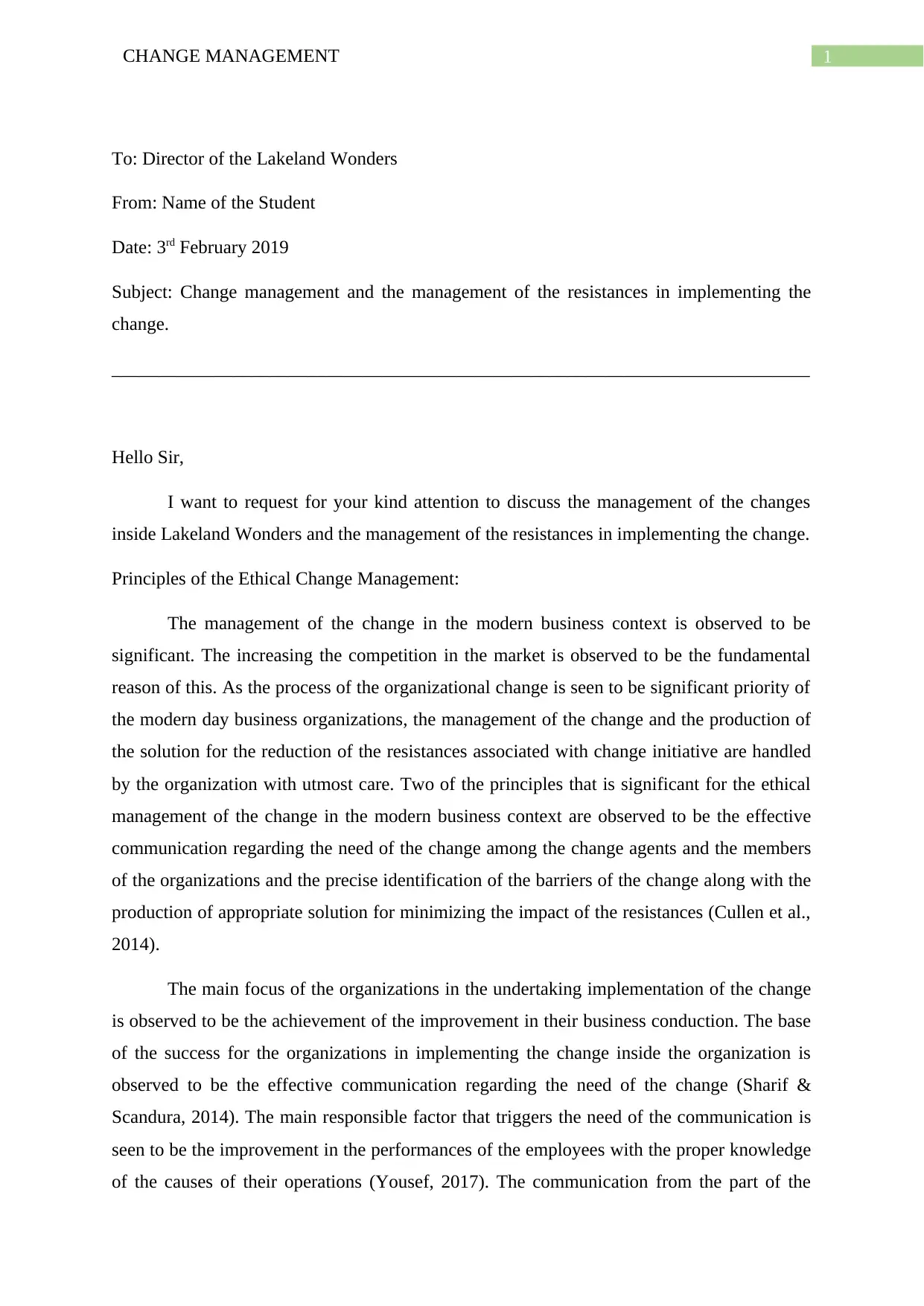
1CHANGE MANAGEMENT
To: Director of the Lakeland Wonders
From: Name of the Student
Date: 3rd February 2019
Subject: Change management and the management of the resistances in implementing the
change.
___________________________________________________________________________
Hello Sir,
I want to request for your kind attention to discuss the management of the changes
inside Lakeland Wonders and the management of the resistances in implementing the change.
Principles of the Ethical Change Management:
The management of the change in the modern business context is observed to be
significant. The increasing the competition in the market is observed to be the fundamental
reason of this. As the process of the organizational change is seen to be significant priority of
the modern day business organizations, the management of the change and the production of
the solution for the reduction of the resistances associated with change initiative are handled
by the organization with utmost care. Two of the principles that is significant for the ethical
management of the change in the modern business context are observed to be the effective
communication regarding the need of the change among the change agents and the members
of the organizations and the precise identification of the barriers of the change along with the
production of appropriate solution for minimizing the impact of the resistances (Cullen et al.,
2014).
The main focus of the organizations in the undertaking implementation of the change
is observed to be the achievement of the improvement in their business conduction. The base
of the success for the organizations in implementing the change inside the organization is
observed to be the effective communication regarding the need of the change (Sharif &
Scandura, 2014). The main responsible factor that triggers the need of the communication is
seen to be the improvement in the performances of the employees with the proper knowledge
of the causes of their operations (Yousef, 2017). The communication from the part of the
To: Director of the Lakeland Wonders
From: Name of the Student
Date: 3rd February 2019
Subject: Change management and the management of the resistances in implementing the
change.
___________________________________________________________________________
Hello Sir,
I want to request for your kind attention to discuss the management of the changes
inside Lakeland Wonders and the management of the resistances in implementing the change.
Principles of the Ethical Change Management:
The management of the change in the modern business context is observed to be
significant. The increasing the competition in the market is observed to be the fundamental
reason of this. As the process of the organizational change is seen to be significant priority of
the modern day business organizations, the management of the change and the production of
the solution for the reduction of the resistances associated with change initiative are handled
by the organization with utmost care. Two of the principles that is significant for the ethical
management of the change in the modern business context are observed to be the effective
communication regarding the need of the change among the change agents and the members
of the organizations and the precise identification of the barriers of the change along with the
production of appropriate solution for minimizing the impact of the resistances (Cullen et al.,
2014).
The main focus of the organizations in the undertaking implementation of the change
is observed to be the achievement of the improvement in their business conduction. The base
of the success for the organizations in implementing the change inside the organization is
observed to be the effective communication regarding the need of the change (Sharif &
Scandura, 2014). The main responsible factor that triggers the need of the communication is
seen to be the improvement in the performances of the employees with the proper knowledge
of the causes of their operations (Yousef, 2017). The communication from the part of the
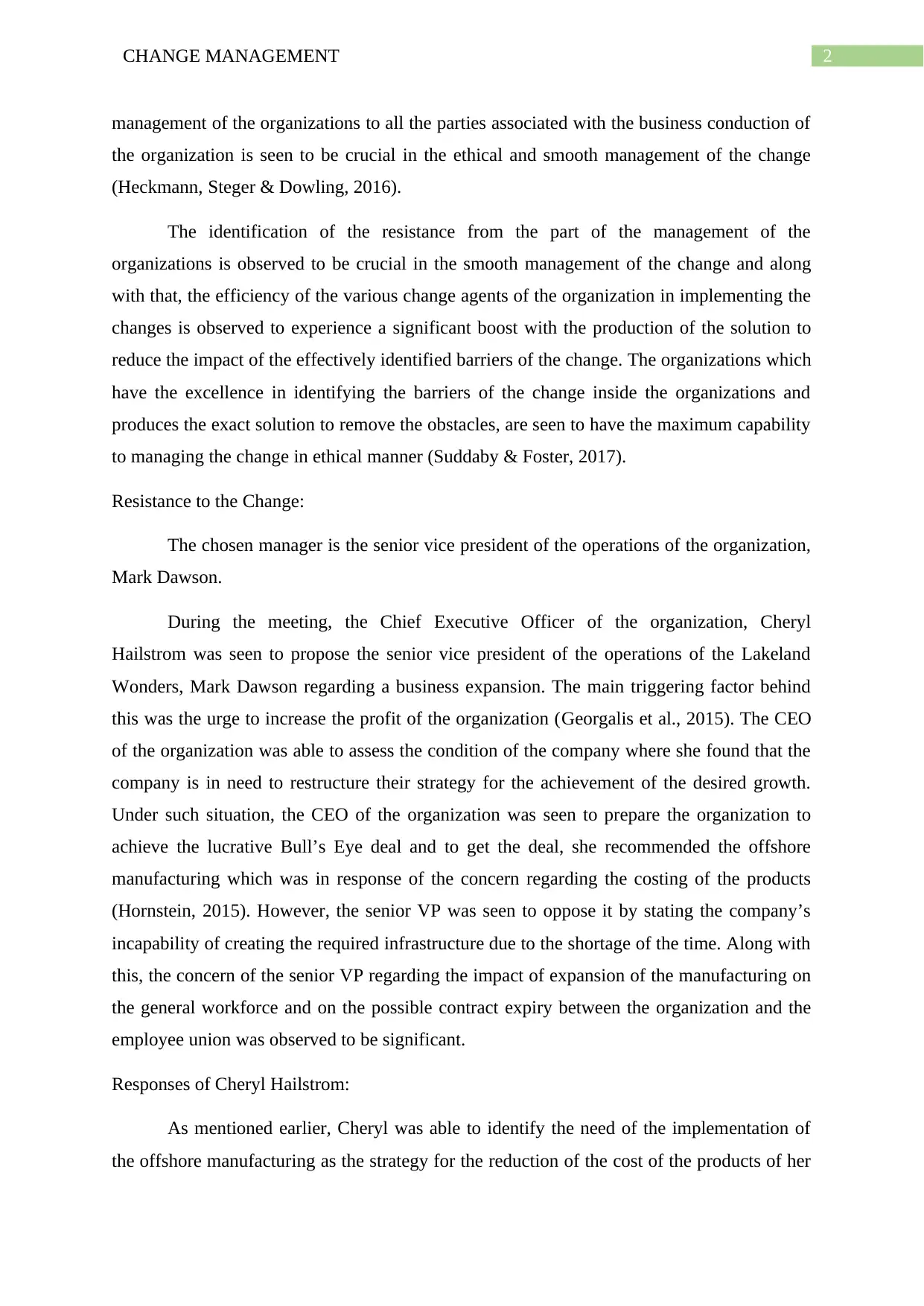
2CHANGE MANAGEMENT
management of the organizations to all the parties associated with the business conduction of
the organization is seen to be crucial in the ethical and smooth management of the change
(Heckmann, Steger & Dowling, 2016).
The identification of the resistance from the part of the management of the
organizations is observed to be crucial in the smooth management of the change and along
with that, the efficiency of the various change agents of the organization in implementing the
changes is observed to experience a significant boost with the production of the solution to
reduce the impact of the effectively identified barriers of the change. The organizations which
have the excellence in identifying the barriers of the change inside the organizations and
produces the exact solution to remove the obstacles, are seen to have the maximum capability
to managing the change in ethical manner (Suddaby & Foster, 2017).
Resistance to the Change:
The chosen manager is the senior vice president of the operations of the organization,
Mark Dawson.
During the meeting, the Chief Executive Officer of the organization, Cheryl
Hailstrom was seen to propose the senior vice president of the operations of the Lakeland
Wonders, Mark Dawson regarding a business expansion. The main triggering factor behind
this was the urge to increase the profit of the organization (Georgalis et al., 2015). The CEO
of the organization was able to assess the condition of the company where she found that the
company is in need to restructure their strategy for the achievement of the desired growth.
Under such situation, the CEO of the organization was seen to prepare the organization to
achieve the lucrative Bull’s Eye deal and to get the deal, she recommended the offshore
manufacturing which was in response of the concern regarding the costing of the products
(Hornstein, 2015). However, the senior VP was seen to oppose it by stating the company’s
incapability of creating the required infrastructure due to the shortage of the time. Along with
this, the concern of the senior VP regarding the impact of expansion of the manufacturing on
the general workforce and on the possible contract expiry between the organization and the
employee union was observed to be significant.
Responses of Cheryl Hailstrom:
As mentioned earlier, Cheryl was able to identify the need of the implementation of
the offshore manufacturing as the strategy for the reduction of the cost of the products of her
management of the organizations to all the parties associated with the business conduction of
the organization is seen to be crucial in the ethical and smooth management of the change
(Heckmann, Steger & Dowling, 2016).
The identification of the resistance from the part of the management of the
organizations is observed to be crucial in the smooth management of the change and along
with that, the efficiency of the various change agents of the organization in implementing the
changes is observed to experience a significant boost with the production of the solution to
reduce the impact of the effectively identified barriers of the change. The organizations which
have the excellence in identifying the barriers of the change inside the organizations and
produces the exact solution to remove the obstacles, are seen to have the maximum capability
to managing the change in ethical manner (Suddaby & Foster, 2017).
Resistance to the Change:
The chosen manager is the senior vice president of the operations of the organization,
Mark Dawson.
During the meeting, the Chief Executive Officer of the organization, Cheryl
Hailstrom was seen to propose the senior vice president of the operations of the Lakeland
Wonders, Mark Dawson regarding a business expansion. The main triggering factor behind
this was the urge to increase the profit of the organization (Georgalis et al., 2015). The CEO
of the organization was able to assess the condition of the company where she found that the
company is in need to restructure their strategy for the achievement of the desired growth.
Under such situation, the CEO of the organization was seen to prepare the organization to
achieve the lucrative Bull’s Eye deal and to get the deal, she recommended the offshore
manufacturing which was in response of the concern regarding the costing of the products
(Hornstein, 2015). However, the senior VP was seen to oppose it by stating the company’s
incapability of creating the required infrastructure due to the shortage of the time. Along with
this, the concern of the senior VP regarding the impact of expansion of the manufacturing on
the general workforce and on the possible contract expiry between the organization and the
employee union was observed to be significant.
Responses of Cheryl Hailstrom:
As mentioned earlier, Cheryl was able to identify the need of the implementation of
the offshore manufacturing as the strategy for the reduction of the cost of the products of her
⊘ This is a preview!⊘
Do you want full access?
Subscribe today to unlock all pages.

Trusted by 1+ million students worldwide
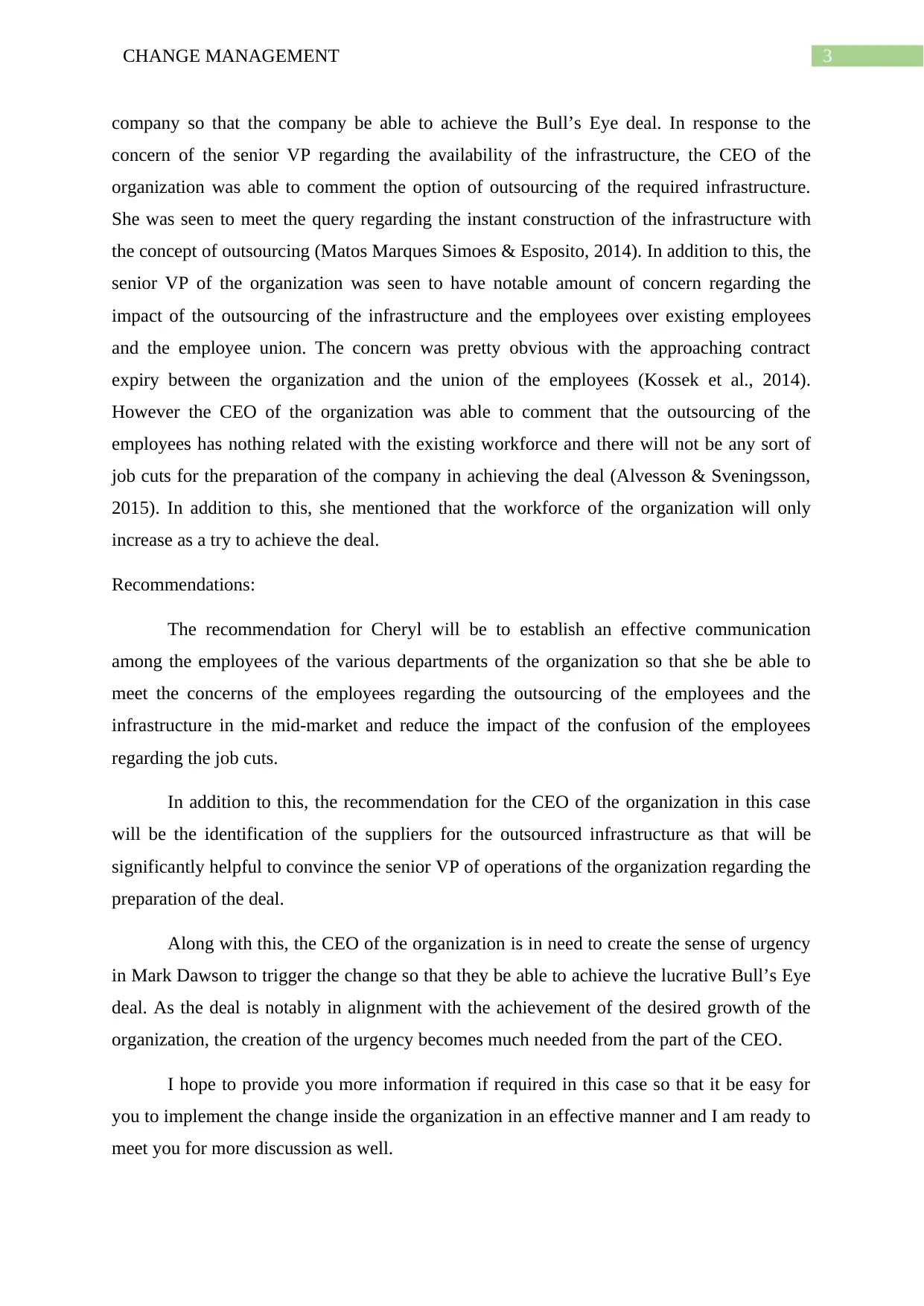
3CHANGE MANAGEMENT
company so that the company be able to achieve the Bull’s Eye deal. In response to the
concern of the senior VP regarding the availability of the infrastructure, the CEO of the
organization was able to comment the option of outsourcing of the required infrastructure.
She was seen to meet the query regarding the instant construction of the infrastructure with
the concept of outsourcing (Matos Marques Simoes & Esposito, 2014). In addition to this, the
senior VP of the organization was seen to have notable amount of concern regarding the
impact of the outsourcing of the infrastructure and the employees over existing employees
and the employee union. The concern was pretty obvious with the approaching contract
expiry between the organization and the union of the employees (Kossek et al., 2014).
However the CEO of the organization was able to comment that the outsourcing of the
employees has nothing related with the existing workforce and there will not be any sort of
job cuts for the preparation of the company in achieving the deal (Alvesson & Sveningsson,
2015). In addition to this, she mentioned that the workforce of the organization will only
increase as a try to achieve the deal.
Recommendations:
The recommendation for Cheryl will be to establish an effective communication
among the employees of the various departments of the organization so that she be able to
meet the concerns of the employees regarding the outsourcing of the employees and the
infrastructure in the mid-market and reduce the impact of the confusion of the employees
regarding the job cuts.
In addition to this, the recommendation for the CEO of the organization in this case
will be the identification of the suppliers for the outsourced infrastructure as that will be
significantly helpful to convince the senior VP of operations of the organization regarding the
preparation of the deal.
Along with this, the CEO of the organization is in need to create the sense of urgency
in Mark Dawson to trigger the change so that they be able to achieve the lucrative Bull’s Eye
deal. As the deal is notably in alignment with the achievement of the desired growth of the
organization, the creation of the urgency becomes much needed from the part of the CEO.
I hope to provide you more information if required in this case so that it be easy for
you to implement the change inside the organization in an effective manner and I am ready to
meet you for more discussion as well.
company so that the company be able to achieve the Bull’s Eye deal. In response to the
concern of the senior VP regarding the availability of the infrastructure, the CEO of the
organization was able to comment the option of outsourcing of the required infrastructure.
She was seen to meet the query regarding the instant construction of the infrastructure with
the concept of outsourcing (Matos Marques Simoes & Esposito, 2014). In addition to this, the
senior VP of the organization was seen to have notable amount of concern regarding the
impact of the outsourcing of the infrastructure and the employees over existing employees
and the employee union. The concern was pretty obvious with the approaching contract
expiry between the organization and the union of the employees (Kossek et al., 2014).
However the CEO of the organization was able to comment that the outsourcing of the
employees has nothing related with the existing workforce and there will not be any sort of
job cuts for the preparation of the company in achieving the deal (Alvesson & Sveningsson,
2015). In addition to this, she mentioned that the workforce of the organization will only
increase as a try to achieve the deal.
Recommendations:
The recommendation for Cheryl will be to establish an effective communication
among the employees of the various departments of the organization so that she be able to
meet the concerns of the employees regarding the outsourcing of the employees and the
infrastructure in the mid-market and reduce the impact of the confusion of the employees
regarding the job cuts.
In addition to this, the recommendation for the CEO of the organization in this case
will be the identification of the suppliers for the outsourced infrastructure as that will be
significantly helpful to convince the senior VP of operations of the organization regarding the
preparation of the deal.
Along with this, the CEO of the organization is in need to create the sense of urgency
in Mark Dawson to trigger the change so that they be able to achieve the lucrative Bull’s Eye
deal. As the deal is notably in alignment with the achievement of the desired growth of the
organization, the creation of the urgency becomes much needed from the part of the CEO.
I hope to provide you more information if required in this case so that it be easy for
you to implement the change inside the organization in an effective manner and I am ready to
meet you for more discussion as well.
Paraphrase This Document
Need a fresh take? Get an instant paraphrase of this document with our AI Paraphraser
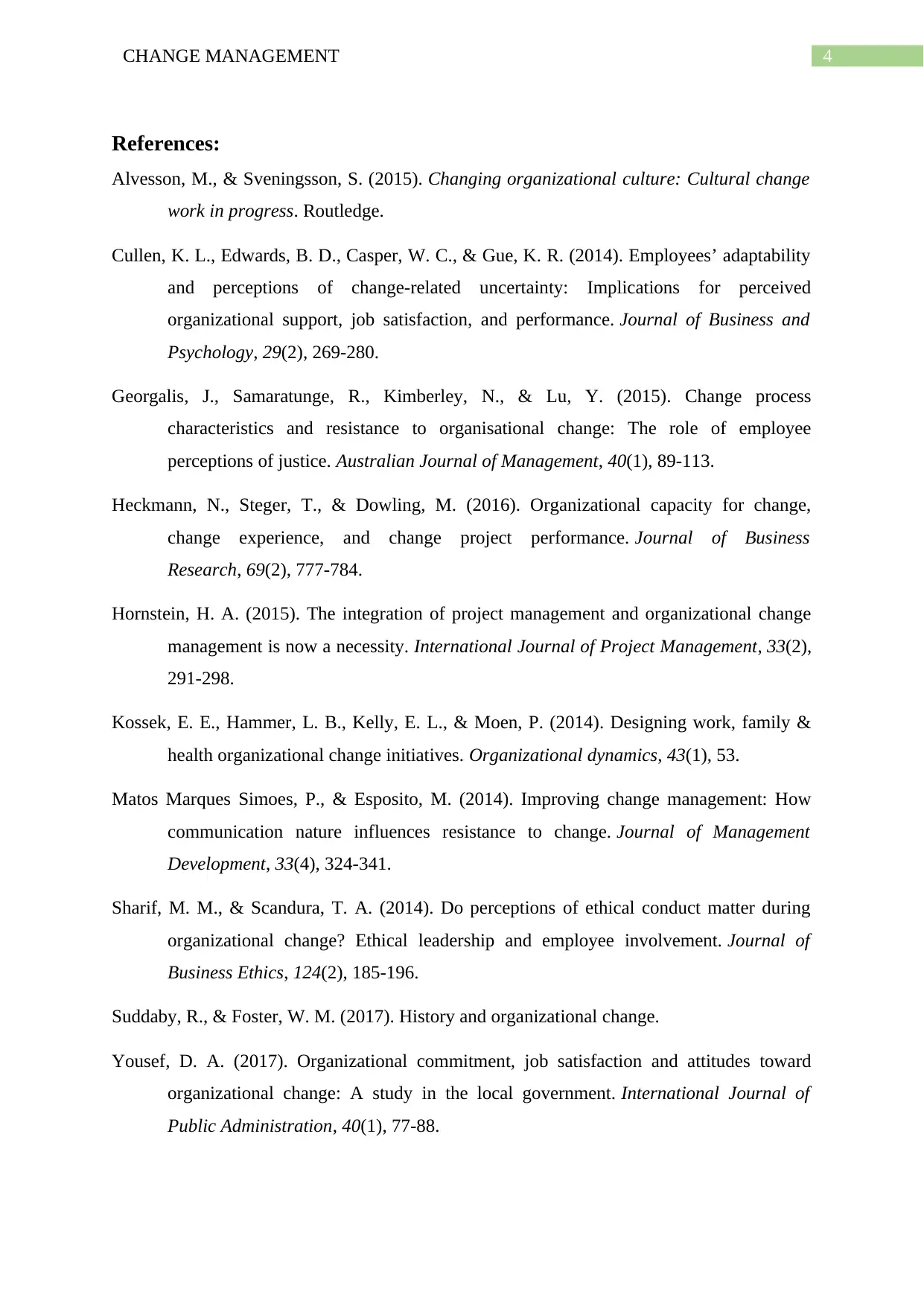
4CHANGE MANAGEMENT
References:
Alvesson, M., & Sveningsson, S. (2015). Changing organizational culture: Cultural change
work in progress. Routledge.
Cullen, K. L., Edwards, B. D., Casper, W. C., & Gue, K. R. (2014). Employees’ adaptability
and perceptions of change-related uncertainty: Implications for perceived
organizational support, job satisfaction, and performance. Journal of Business and
Psychology, 29(2), 269-280.
Georgalis, J., Samaratunge, R., Kimberley, N., & Lu, Y. (2015). Change process
characteristics and resistance to organisational change: The role of employee
perceptions of justice. Australian Journal of Management, 40(1), 89-113.
Heckmann, N., Steger, T., & Dowling, M. (2016). Organizational capacity for change,
change experience, and change project performance. Journal of Business
Research, 69(2), 777-784.
Hornstein, H. A. (2015). The integration of project management and organizational change
management is now a necessity. International Journal of Project Management, 33(2),
291-298.
Kossek, E. E., Hammer, L. B., Kelly, E. L., & Moen, P. (2014). Designing work, family &
health organizational change initiatives. Organizational dynamics, 43(1), 53.
Matos Marques Simoes, P., & Esposito, M. (2014). Improving change management: How
communication nature influences resistance to change. Journal of Management
Development, 33(4), 324-341.
Sharif, M. M., & Scandura, T. A. (2014). Do perceptions of ethical conduct matter during
organizational change? Ethical leadership and employee involvement. Journal of
Business Ethics, 124(2), 185-196.
Suddaby, R., & Foster, W. M. (2017). History and organizational change.
Yousef, D. A. (2017). Organizational commitment, job satisfaction and attitudes toward
organizational change: A study in the local government. International Journal of
Public Administration, 40(1), 77-88.
References:
Alvesson, M., & Sveningsson, S. (2015). Changing organizational culture: Cultural change
work in progress. Routledge.
Cullen, K. L., Edwards, B. D., Casper, W. C., & Gue, K. R. (2014). Employees’ adaptability
and perceptions of change-related uncertainty: Implications for perceived
organizational support, job satisfaction, and performance. Journal of Business and
Psychology, 29(2), 269-280.
Georgalis, J., Samaratunge, R., Kimberley, N., & Lu, Y. (2015). Change process
characteristics and resistance to organisational change: The role of employee
perceptions of justice. Australian Journal of Management, 40(1), 89-113.
Heckmann, N., Steger, T., & Dowling, M. (2016). Organizational capacity for change,
change experience, and change project performance. Journal of Business
Research, 69(2), 777-784.
Hornstein, H. A. (2015). The integration of project management and organizational change
management is now a necessity. International Journal of Project Management, 33(2),
291-298.
Kossek, E. E., Hammer, L. B., Kelly, E. L., & Moen, P. (2014). Designing work, family &
health organizational change initiatives. Organizational dynamics, 43(1), 53.
Matos Marques Simoes, P., & Esposito, M. (2014). Improving change management: How
communication nature influences resistance to change. Journal of Management
Development, 33(4), 324-341.
Sharif, M. M., & Scandura, T. A. (2014). Do perceptions of ethical conduct matter during
organizational change? Ethical leadership and employee involvement. Journal of
Business Ethics, 124(2), 185-196.
Suddaby, R., & Foster, W. M. (2017). History and organizational change.
Yousef, D. A. (2017). Organizational commitment, job satisfaction and attitudes toward
organizational change: A study in the local government. International Journal of
Public Administration, 40(1), 77-88.
1 out of 5
Related Documents
Your All-in-One AI-Powered Toolkit for Academic Success.
+13062052269
info@desklib.com
Available 24*7 on WhatsApp / Email
![[object Object]](/_next/static/media/star-bottom.7253800d.svg)
Unlock your academic potential
Copyright © 2020–2025 A2Z Services. All Rights Reserved. Developed and managed by ZUCOL.





